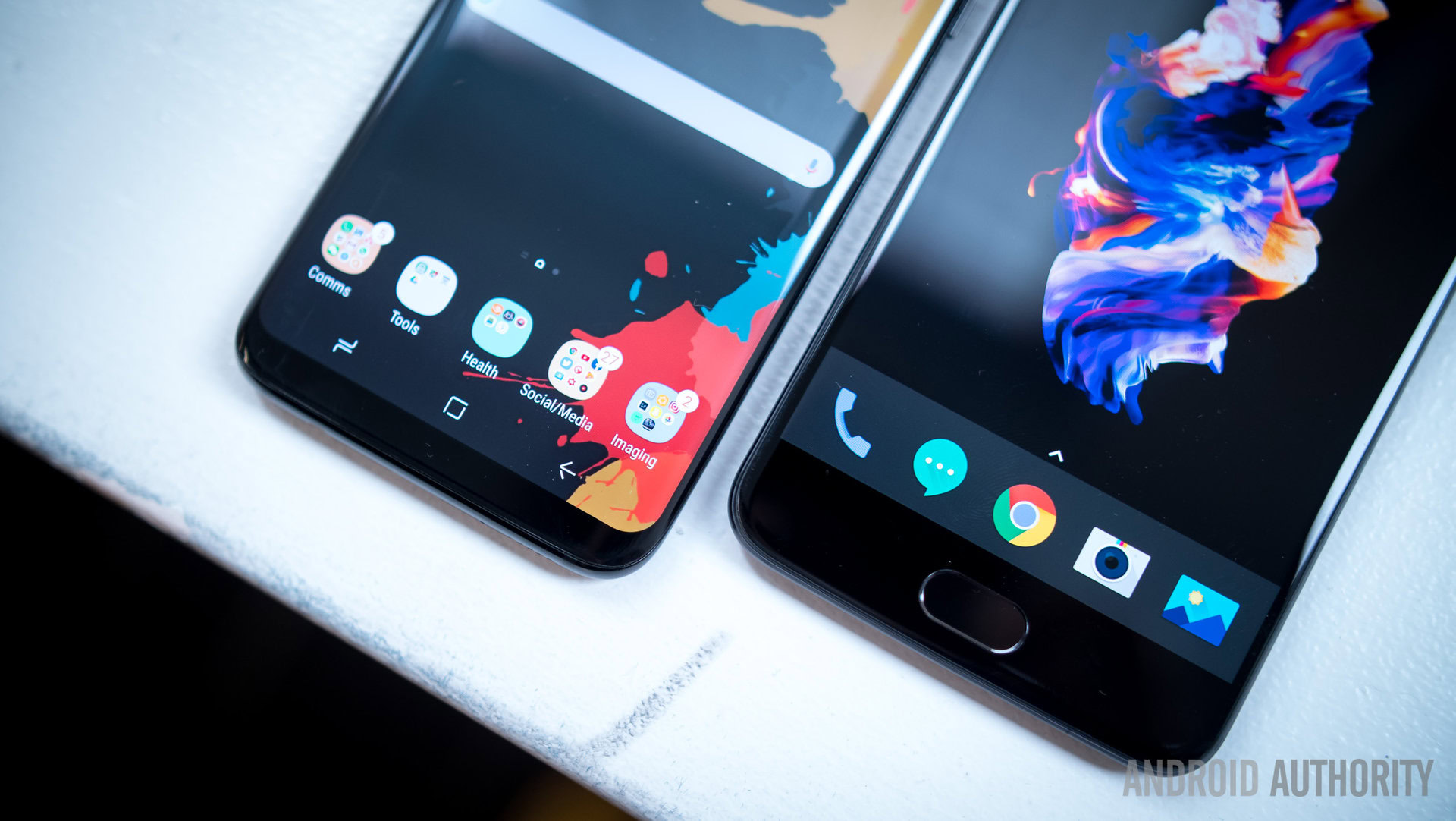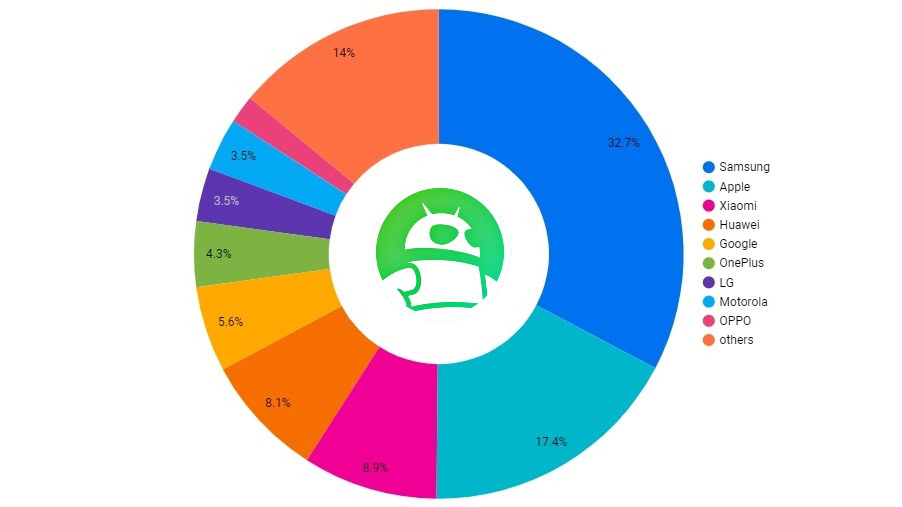Affiliate links on Android Authority may earn us a commission. Learn more.
The phones our readers used the most in 2019
Published onDecember 15, 2019

Every now and then, we like to give you a peek at the devices our readers use to browse Android Authority every day.
The last time we did it was in February 2019, but now that the year is ending, it’s a good time to look back and try to make some sense of the long-term trends. With millions of people visiting us every month, the sample size is massive. Let’s dive right in.
How we gathered the data
Like most websites, at Android Authority we use Google Analytics, a tool that tells us which pages our readers browse, where these readers come from, and what devices they use, among other things.
This anonymous data gives us a glimpse at an incredibly diverse set of user types, ranging from super savvy to total noobs, and the thousands of smartphone models they use. And let me tell you, these phones run the gamut: you get the boringly popular (uhm, lots of iPhones) and the esoterically rare (HTC ChaCha) and everything in between.
Obviously, the data is heavily skewed towards our core audience of Android fans, but it’s still a great look at the smartphone zeitgeist of 2019.
Apple Authority
The phone our readers used the most in 2019 is “Apple iPhone.”
*record scratch* *freeze frame*
Yep, that’s on Android Authority. You’re probably wondering how we ended up in this situation.
The explanation is pretty simple. Google Analytics lumps togethers all the iPhone models ever released under one entry – “Apple iPhone.” But it doesn’t do that for the various Samsung Galaxy phones, or Pixels, or HUAWEI Mates out there. Which means the iPhone gets first place. Same deal with the iPad.
If you’ve read any of the previous installments of this series, you probably won’t be surprised by this. It won’t change anytime soon either, unless Google decides to suddenly change how it identifies iOS devices.
Plus, we do strive to reach our friends over in iOS land. I mean, we just published a post called Dear Android and Apple fans: In 2020, can we permanently end the hate? That’s a new year resolution everybody can get behind.
Class of 2017 checking in
Right after the nebulous all-in-one iPhone comes the Galaxy S8, or, to be precise, the SM-G950F version, an unlocked model sold in Europe and other markets.
Next up come the Google Pixel 2 XL, a Galaxy Note 8 version, and another Galaxy S8 model.
These phones were all released in 2017, which, at the pace of change in the smartphone industry, feels like forever ago.
As a member of tech media, this is an eye-opening stat. We spend so much time obsessing over leaks, and tiny new details, and the ephemeral Next Big Thing, that we tend to forget that most people actually use a phone that’s two or three years old.
And those are the lucky ones. There are plenty of devices in our logs that are positively ancient. Case in point, at least 9,000 readers visited us on a Galaxy S2, announced in February 2011. Incidentally, the Galaxy S2 was my first Android love and I still think about how good it was.
The moral of the story is we in tech media need to spend more time thinking about the many older devices out there and how we can better serve their users. In related reading, only one in ten US customers buys a phone that costs $1,000 or more.
- Apple iPhone
- Apple iPad
- Samsung SM-G950F Galaxy S8
- Google Pixel 2 XL
- Samsung SM-N950U Galaxy Note8
- Samsung SM-G950U Galaxy S8
- Samsung SM-N960U Galaxy Note9
- Samsung SM-G960U Galaxy S9
- Samsung SM-G965U Galaxy S9+
- Google Pixel 2
- Google Pixel 3 XL
- Xiaomi Redmi Note 4
- Samsung SM-G965F Galaxy S9+
- Google Pixel 3
- Samsung SM-N960F Galaxy Note9
- Samsung SM-G960F Galaxy S9
- Samsung SM-G955U Galaxy S8+
- Samsung SM-G975F Galaxy S10+
- Samsung SM-N950F Galaxy Note8
- Samsung SM-G935F Galaxy S7 Edge
- Samsung SM-G930F Galaxy S7
- Samsung SM-G955F Galaxy S8+
- OnePlus A6013 6T
- Xiaomi Redmi Note 5 Pro
- OnePlus A5010 5T
- Xiaomi Redmi Note 5
- OnePlus A6000 6
- Xiaomi Mi A1
- Samsung SM-G975U Galaxy S10+
- Samsung SM-G973F Galaxy S10
- OnePlus A5000 5
- OnePlus A6003 6
- OnePlus A3003 3
- Google Pixel XL
- Xiaomi Redmi Note 7
- OnePlus 6010 6T
- Google Pixel
- Xiaomi POCOPHONE F1
- Samsung SM-G930V Galaxy S7
- HUAWEI LYA-L29 Mate 20 Pro
- ASUS X00TD Zenfone Max Pro (M1)
- HUAWEI CLT-L29 P20 Pro
- Xiaomi POCO F1
- HUAWEI ANE-LX1 P20 Lite
- Xiaomi Mi A2
- Motorola Moto G (5) Plus
- Xiaomi Redmi Note 6 Pro
- Samsung SM-G973U Galaxy S10
- Xiaomi Redmi Note 5A
- Samsung SM-G610F Galaxy J7 Prime
It’s Samsung’s world, we just live in it
Looking at the rankings, one brand utterly dominates our readership. Samsung takes 13 places out of the top 20. If you ignore the iPhone and the iPad, you’re left with just five devices that are not made by Samsung.
Google holds the line with four models: the Pixel 2 (#10) and 2 XL (#4), and the Pixel 3 (#14) and Pixel 3 XL (#11).
The only other brand in top 20 is Xiaomi, represented by its venerable budget champion of 2016-2017, Redmi Note 4 (#12).
Samsung is mostly represented by its flagships. In the top 50, we find various versions of the Galaxy S7, S8, S9, and S10, plus the Galaxy Note 8 and Note 9.
Interestingly, you have to go down to #50 to find the first budget Samsung phone, the Galaxy J7 Prime.
Fun fact: over the last year, 1,651 mad lads visited Android Authority from a Galaxy Note 7. You know, the one that was a fire hazard and was supposed to be fully recalled. I guess they’re probably safe if they haven’t blown up by now?
David vs Goliath
Everyone loves a David vs Goliath story, right? Here’s my very nerdy retelling: scrappy little OnePlus managed to beat big bad HUAWEI in our logs, both in terms of how many devices rank in the top 50 (OnePlus has 7 models, HUAWEI just 3) and in actual rankings: OnePlus 6T (#23), OnePlus 5T (#25), OnePlus 6 A6000 (#27), OnePlus 5 (#31), OnePlus 6 A6003 (#32), OnePlus 3 (#33), and another OnePlus 6T version (#36), versus HUAWEI Mate 20 Pro (#40), P20 Pro (#42), and P20 Lite (#43).
It’s a great showing for OnePlus, which is no global powerhouse, but obviously holds outsized influence among enthusiasts.
As for HUAWEI, you’d expect the Chinese mammoth to do better, but you have to keep in mind there’s a certain inertia at play here. Usage share trails market share. We expect HUAWEI to go up the rankings in the next couple of years.
Insert Xiaomi pun here
Xiaomi is the other big fan favorite, right behind Samsung. The Chinese company holds 10 spots in the top 50, mostly thanks to its Redmi Note line. Redmi models ranging from the Note 4 to the Note 7 brought Xiaomi 6 positions, the rest going to the Pocophone F1 and the Xiaomi Mi A1 and Mi A2.
These are all phones that Xiaomi sold by the tens of millions in India, around Asia, and in Europe. You won’t see any of the flagship Mi devices, which were more focused on China. Very few people read us in China, so that’s no surprise. In contrast, India is our second largest market after the US.
Brand extravaganza

Looking at brands instead of specific devices changes the picture slightly. Samsung comfortably takes the first spot, and by a massive margin – over 32% of the readers who visited us in 2019 used a Samsung device, compared to 17.4% Apple (iPhone + iPad), 8.9% Xiaomi, 8.1% HUAWEI, and 5.6% Google. The top-ten is completed by OnePlus, LG, Motorola, OPPO, and vivo.
Other interesting rankings include Nokia (#11), realme (#17), Essential (#30), SonyEricsson (#51), Fairphone (#116), RED (#117) (RIP), and, uhm, Tesla (#165), which, I’m sad to say, is not Elon Musk’s secret phone.
The manufacturer overview stat gets really exotic once you move beyond #50 and we recorded a total of 1,605 different brands of mobile devices (not all of them are real manufacturers though, as Analytics counts some name variations as different entries). At the very end of the tail, brands like Bell Fung, Kraun, Roverpad, UNUSUAL, Verykool, and Xion all had just one pageview in our 2019 records.
Shout out to the person using that Verykool Maverick II S5530 who visited us once in 2019!
Pixel Feature Drops: Google making old phones new again is great news for us all
Samsung, HUAWEI, and Xiaomi on the rise
A quick comparison between January 2019 and December 2019 gives us a hint of how the smartphone ecosystem has changed throughout the year.
For one, the market is consolidating. Taken together, the top five manufacturers in our logs (Samsung, Apple, Xiaomi, HUAWEI, and Google) now account for 70.76% of our readership, up 2.5% from the beginning of the year.
All the top five brands have seen their shares increase, except Google. Despite the release of the popular Pixel 3a, Google’s share in our logs went down by 1.75 percentage points.
Somehow surprisingly, Samsung has seen the biggest increase, followed by Xiaomi, and HUAWEI.
Of course, there are many caveats here and we don’t claim to offer anything resembling real market research – it’s just a fun thing to read on a Sunday. And that’s a wrap. I hope you enjoyed this look behind Android Authority’s curtains. Do you find yourself in any of these stats?
Oppo’s under-display camera means we can finally stop arguing about notches